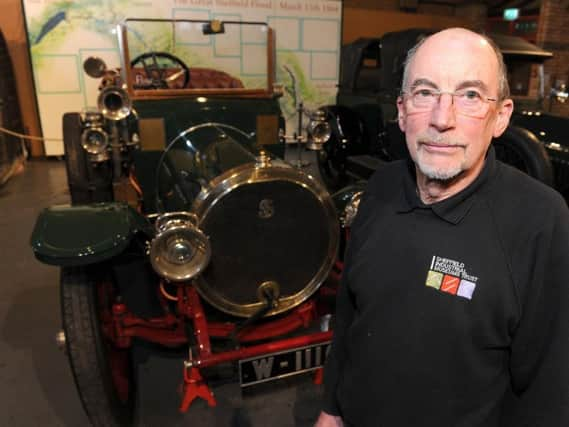'It's part of our heritage': Museum's race against time to keep rare Sheffield-made car


Sheffield-Simplex cars were carefully assembled at Fitzwilliam Works, Tinsley, from 1908, backed financially by coal magnate Earl Fitzwilliam of Wentworth Woodhouse who proudly believed the city could produce the finest vehicles in the world.
About 1,500 standard passenger models were made. But today only three survive and, for a short time only, two of the trio are on display simultaneously at the Kelham Island Museum, where they stand side-by-side, all gleaming bodywork, enormous tyres and buttoned leather seats.
Advertisement
Hide AdAdvertisement
Hide AdOne of the cars, a 1920 prototype that would have gone into full production if the company had survived the First World War, has been part of the museum's collection for years and is on permanent display.
Its temporary partner, however, is an open-bodied variety dating from 1908 that is privately owned and up for sale, having been loaned to Sheffield Industrial Museums Trust. The car could leave the country altogether unless the trust can find £100,000 before April to secure the piece of automotive history for the city.
"It's amazing," says engineer Keith Wall. "I wasn't working on the day it came down but I went in just to watch it arrive and help push it in."
Clearly, Keith is in his element. A retired mechanic, he used to run his own garage, so tending to cars with such exceptional rarity value is something of a dream. "It's a real privilege."
Advertisement
Hide AdAdvertisement
Hide AdThe 1908 car was exported to Australia two years after it was built, and has had an eventful life. It was used as a taxi in Sydney, as a workhorse to deliver bricks to building sites in Adelaide and the engine was once removed to power a water pump for sheep on a farm.
In the early 1980s the vehicle was bought by steelmaker Lord Riverdale, shipped back to England and completely restored at a cost of more than £85,000. Its most recent owner, enthusiast John Thring from Pontefract, has already attempted to sell it on eBay and was offered just under £100,000 for the car during an auction at Bonham's in London.
"He's ageing now, and obviously these things don't drive themselves," says Keith. "A guy in Holland was interested but decided it wasn't for him after seeing how it drove."
Steve Myers, an expert who has written a book on Sheffield's vintage motors, suggested the idea of bringing the car to the museum, and John agreed to give the trust some time to find enough money to put it in the Kelham collection.
Advertisement
Hide AdAdvertisement
Hide Ad"For us it's a good thing," says Keith. "It's absolutely part of our heritage. It's right at the beginning of the motor industry, it was so innovative for its time."
The 1908 touring car was originally sold as a single-speed model in chassis form for £750 - expensive, considering it was made by workers earning £1 a week. It has no gear box as such - instead it is fitted with two gears in the back axle, one of which is for emergencies only - and has a top speed of 60.68mph, reaching 0-30 in 9.7 seconds. "Pretty quick," quips Keith.
In 1911 the vehicle was driven from Land's End to John O'Groats, a challenge repeated by Lord Riverdale in the mid-1980s, and 'it still goes', says Keith.
"It was basic but it was way in front of its time. It's been on several rallies."
Advertisement
Hide AdAdvertisement
Hide AdHe adds: "The crazy thing is, for a hundred grand it's a very cheap car. More modern classics that are more usable, something like a Lotus Elan, now fetch something like 60 to 70 thousand quid. Yet something as rare as this, a unique car, is £100,000. It's usually because of the driveability; people want something they can actually use, whereas there's an art to driving this. It weighs a ton and three quarters and only has back brakes."
The third survivor, a four-door, deluxe type from 1913 with a cabriolet body, is on display at a science centre in Perth, Australia.
The fundraising appeal is being led by the trust's technical services manager Eddy Foster. It won't be easy, Keith admits - ideally a large, one-off donation is needed from a generous sort, given the tight deadline.
"We've only got until the end of March so rather than it being something like crowdfunding, which can take a long time to do, we need a benefactor to put it into the museum."
Advertisement
Hide AdAdvertisement
Hide AdThe trust hopes to use the 1908 car for outreach work, as it does with the 1920 model, inspiring the next generation of engineers. It is also a reminder of a time when long-gone motor firms like Cavendish, La Planta, Richardson and Stringer made vehicles in Sheffield. Parked beside the museum's Simplexes is a well-preserved example by Charron Laycock, which traded in Millhouses.
"A lot of people don't even know Sheffield had a motor industry," says Keith. "If things had worked out differently we could have been as big as somewhere like Coventry for car manufacturing."